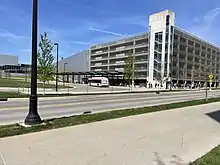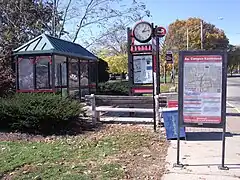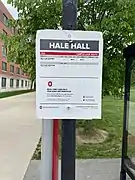 A CABS bus driving the Campus Loop South route | |
| Parent | Ohio State University |
|---|---|
| Founded | 1923 |
| Service area | OSU Columbus campus and off-campus housing |
| Routes | 5[1] |
| Stops | 46[1] |
| Annual ridership | 5 million[2] |
| Fuel type | Compressed natural gas, Diesel |
| Director | Beth Snoke[3] |
| Website | ttm |
Campus Area Bus Service (CABS) is a free public transportation system at the Ohio State University's Columbus campus. The system consists of five bus routes that connect various points of Ohio State's campus, and the immediate off-campus area. The system connects with the Central Ohio Transit Authority's bus routes at several points.[4]
The system is one of the largest campus transit systems in the United States.[5] Ridership has grown from 4 million passengers in 2003 to an estimated 5 million passengers in 2015.[6][2]
History
Bussing has been available at Ohio State since at least 1923. At the time, there was a single 1921 Reo bus that was made out of plywood and had solid rubber tires. When it was first offered, it was primarily used to transport students between the main campus, and the agricultural campus across the Olentangy River.[7]
By the 1960s, there were 19 buses in the fleet, and buses ran as far north as Ohio State University Airport, and as far south as the Children's Hospital. There was both regularly scheduled service, and on-demand service available by calling the bus operator.[7][8]
In the 1970s, there were a series of pushes by the student governments to provide bus service between the campus area, and off-campus area where most students lived due to safety concerns.[9] In 1971, a group of students chartered a bus from the Columbus Transit Company to act as a shuttle between on-campus and off-campus arrest. Two routes served the area, one each for North and South campuses. When the service began, it cost $4 for a quarter-long pass, or 25¢ per ride. It was originally operated as a flag-stop service, meaning that students could board the bus from any intersection by signaling to the bus.[10] This off-campus service was discontinued in January 1972 due to low ridership.[11]
In 1978, a bus linking the on and off campus areas, this time operated by Ohio State, began due to an increasing rate of rape occurring near campus.[12]
In 1991, Ohio State attempted to cut daytime bus service over its cost, but halted the move after receiving negative feedback.[13] Student leaders requested time to notify would-be passengers, and daytime service was cut in January 1992.[14]
In 1998, the university began to heavily invest in bus service, raising its budget from $1 million to $2.5 million. A traffic study that year determined that adequate parking could never be built. The university found that investing in transit is cheaper than building garages. It raised parking fees for the main campus and used the funds to purchase additional buses and expand service hours (from 29,000 to 83,000). CABS began offering fixed route overnight as well as weekend service as part of these changes. Ridership subsequently increased from 1.2 million in 1998 to 2.3 million in 1999.[15]
In 2009, CABS buses were equipped with GPS devices, giving passengers real-time arrival times for the bus system.[5]
In 2012, the university gave parking operations to a private contractor. The move cut off the bus system's revenue stream, so the university moved to fund the service from its endowment.[16]
In 2013, the Wexner Medical Center's Patient Courtesy Shuttle system was transferred to Transportation & Traffic Management, the organization that oversees CABS. This allowed the integration of PCS drivers into one seniority system, and ensured the availability of additional drivers in the event of illness, expansion of service, etc. The Patient Courtesy Shuttle service began overnight service as part of this transition, providing door to door rides for late night staff as well as visitors and patients of the Hospital.
On November 23, 2018, a bus carrying Ohio State University Wexner Medical Center employees was hit by a truck at an intersection resulting in at least 17 injuries. The truck driver was determined to be at fault. Following the incident, the university stated it would add more buses at peak times on the route to reduce overcrowding and that it was purchasing additional buses.[17]
The Covid-19 outbreak in 2020, along with ongoing construction projects on Central and West Campus, led to a reorganization of routes and service times for transit operations. Increased bus frequency was initially required after students were permitted to return to campus but required to follow social distancing guidelines. Fixed route overnight service was replaced by a fully on-demand system utilizing shuttle buses which allow greater flexibility along with Medical Center Patient Courtesy Shuttle services.
Services
CABS routes can be planned through the Pivot app, a tool developed by Smart Columbus in 2020 for multi-modal trip planning and payment.[18][19] An earlier service, called Connect and Ride or C-Ride, was developed with researchers at Battelle Memorial Institute in 2014.[20]
Routes

CABS currently operates five routes on Ohio State's main campus. Most routes run from early morning to night on weekdays, with some routes also offering late-night, 24-hour, and weekend service.[1] Additionally, the university provides a pickup and dropoff service for disabled students.[21]
| Abbreviation | Route name | Route description |
|---|---|---|
| BE | Buckeye Express | Travels from central campus with a clockwise loop around the Ohio Union |
| CLS | Campus Loop South | Travels counter-clockwise around central campus, and up to the Buckeye Lot |
| ER | East Residential | Travels from the Ohio Union to off-campus housing east of campus |
| MC | Med Center Express | Travels from the Carmack parking lots to the Herrick Drive Transit Hub |
| CC | Campus Connector | Travels clockwise around central campus, and to the Carmack parking lots |
Operation
The Campus Area Bus Service employs students for bus operation; approximately 67 percent of its drivers were students, provided with on-the-job training, in 2009.[5]
Fleet
All of the buses in the CABS fleet are outfitted with automated passenger counters and GPS devices to gather data about ridership and bus performance as a part of Ohio State's Campus Transit Lab.[22]
At least 33 of the 47 total buses in the fleet are powered by compressed natural gas (CNG) in an effort to reduce emissions, including six that were purchased with funds from the Volkswagen emissions scandal settlement.[23] The transition from diesel to CNG began around 2015 due to the environmental and cost benefits, prompting a long-term plan to move the entire bus fleet to CNG. The move follows COTA, which began operating its first 30 CNG buses in 2013.[24] CABS' fleet also includes several hybrid-electric vehicles.[25]
Active bus fleet
| Year | Manufacturer & Model | Length | Engine Type | Numbers | Notes |
|---|---|---|---|---|---|
| 2005 | Motor Coach Industries J4500 |
45 ft (14 m) | Diesel | 585, 586 (2 buses) |
Caterpillar C13 engines and Allison transmissions. Originally delivered with ZF Astronic transmissions. |
| 2011 | Gillig Gillig Low Floor |
40 ft (12 m) | Diesel | 1101–1110 (10 buses) |
Cummins ISL engines and Voith transmissions. |
| 2011 | Diesel-Electric Hybrid |
1111–1112 (2 buses) |
Cummins ISB engines and Allison Hybrid drives. | ||
| 2012 | Motor Coach Industries J4500 |
45 ft (14 m) | Diesel | 641, 644 (2 buses) |
Cummins ISX engines and Allison transmissions. |
| 2013 | Gillig Gillig Low Floor |
40 ft (12 m) | Diesel | 1301–1306 (6 buses) |
Cummins ISL engines and Voith transmissions |
| 2015 | CNG | 1501–1504 (4 buses) |
Westport Cummins ISL-G engines and Voith transmissions | ||
| 2016 | Motor Coach Industries J4500 |
45 ft (14 m) | Diesel | 417, 613 (2 buses) |
Cummins ISX engines and Allison transmissions. |
| 2017 | Gillig Gillig Low Floor |
40 ft (12 m) | CNG | 1701–1706 (6 buses) |
Westport Cummins ISL-G engines and Voith transmissions |
| 2018 | 1801–1806 (6 buses) | ||||
| 2019 | 1901–1906 (6 buses) | ||||
| 2020 | 2001–2003 (3 buses) | ||||
| 2021 | 2101–2104 (4 buses) | ||||
| 2022 | 2201–2204 (4 buses) | ||||
Historic bus fleet
| Year | Manufacturer & Model | Length | Engine Type | Numbers | Notes |
|---|---|---|---|---|---|
| 1995 | Flxible Flxible Metro |
40 ft (12 m) | Diesel | 9501–9506 (6 buses) |
Purchased used in late 2010 to offset late delivery of new vehicles. Retired in late 2011. Cummins C8.3 engines and ZF Ecomat transmissions. |
| 1997 | Blue Bird Corporation CSFE |
30 ft (9.1 m) | 97217, ?, ? (3 buses) |
Retired in early 2000s. Purchased by a local charter bus company. Cummins ISB engines and Allison transmissions. | |
| 1998 | Gillig Gillig Phantom |
40 ft (12 m) | 9801–9805 (5 buses) |
Retired in 2016. Cummins M11 engines and Allison transmissions. | |
| 1998 | NovaBus NovaLFS |
98542 (1 bus) |
Factory demonstrator unit. Retired in 2009. Delivered to COTA and turned into an accessibility simulator. Detroit Diesel Series 40E engine and Allison transmission. | ||
| 1999 | Gillig Gillig Phantom |
9901–9904 (4 buses) |
Retired in 2017. Cummins ISM engines and Allison transmissions. | ||
| 1999 | NovaBus NovaLFS |
99541 (1 bus) |
Factory demonstrator unit. Scrapped in 2010. Cummins ISC engine and Allison transmission. | ||
| 2001 | Gillig Gillig Phantom |
35 ft (11 m) | 2101–2105 (5 buses) |
Retired in 2018. Cummins ISM engines and Allison transmissions. | |
| 2002 | 40 ft (12 m) | 2201–2206 (6 buses) |
Scrapped in 2019 with EPA funds. Cummins ISM engines and Voith transmissions. | ||
| 2003 | Gillig Gillig Low Floor |
2301–2302 (2 buses) |
Purchased used in 2017 to offset late delivery. Retired in 2020. Cummins ISL engines and Voith transmissions. | ||
| 2005 | Gillig Gillig Phantom |
2501–2506 (6 buses) |
2505 scrapped due to fire in 2010. Remaining units retired 2020. Cummins ISM engines and Voith transmissions. | ||
| 2016 | ElDorado National-California ENC Axess |
Hydrogen fuel cell | 1601 (1 bus) |
Operated as part of a vehicle demonstration. Owned by SARTA. Returned to SARTA in 2018. |
Gallery
 A CABS bus stop with previous branding
A CABS bus stop with previous branding The interior of a CABS bus, with dividers installed on seats due to the COVID-19 pandemic
The interior of a CABS bus, with dividers installed on seats due to the COVID-19 pandemic A CABS and COTA stop across from Hale Hall
A CABS and COTA stop across from Hale Hall An example CABS timetable
An example CABS timetable A CABS bus in a previous livery
A CABS bus in a previous livery
See also
References
- 1 2 3 "Campus Area Bus Service - 2022-2023 Service Hours and Frequency" (PDF). October 7, 2020. Retrieved November 29, 2022.
- 1 2 McCord, Mark R.; Mishalani, Rabi G.; Ettefagh, Mahsa (January 2015). "Effect of Real-Time Passenger Information Systems on Perceptions of Transit's Favorable Environmental and Traffic Reduction Roles". Transportation Research Record: Journal of the Transportation Research Board. 2538 (1): 102–109. doi:10.3141/2538-12. ISSN 0361-1981. S2CID 112713003. Archived from the original on April 14, 2021. Retrieved April 13, 2021.
- ↑ Smola, Jennifer. "Ohio State starts massive Cannon Drive project, spurred by flood on Iowa's campus". The Columbus Dispatch. Archived from the original on April 13, 2021. Retrieved April 13, 2021.
- ↑ "CABS System Map". Archived from the original on April 30, 2021. Retrieved November 29, 2022.
- 1 2 3 Pyle, Encarnacion (December 12, 2009). "No more waiting at the bus stop - OSU outfits buses with GPS so students know when next will arrive". NewsBank. Columbus Dispatch. Retrieved May 19, 2021.
- ↑ "University soy biodiesel program launched at FSR". Lancaster Eagle-Gazette. September 28, 2003. p. 12B.
- 1 2 "University Bus In 42nd Year". The Lantern. Ohio State University School of Communication. August 5, 1965.
- ↑ "Some Students Beat Bell Thanks To Shuttle Buses". The Lantern. Ohio State University School of Communication. April 6, 1961.
- ↑ Mahoney, Patti (April 29, 1970). "Funds to Decide Bus Fate". The Lantern.
- ↑ Janes, Terri (November 30, 1971). "'Dry Run' tests CTC bus service in campus area". The Lantern.
- ↑ "CABS discontinued". The Lantern. Ohio State University School of Communication. January 17, 1972.
- ↑ Stoiber, Julie (January 25, 1978). "Off-campus bus to combat rape". The Lantern. Ohio State University School of Communication.
- ↑ Honig, Douglas (September 23, 1991). "Bus service reduced during Fall Quarter". The Lantern. Ohio State University School of Communication.
- ↑ Doulin, Tim (January 7, 1992). "OSU Curtails its Daytime Bus Service". NewsBank. Columbus Dispatch. Retrieved May 19, 2021.
- ↑ Williams, Brian (February 3, 2000). "Buses Play Big Part in OSU Strategy - the Service Has Eased the Tight Parking Situation on Campus, Officials Say". NewsBank. Columbus Dispatch. Retrieved May 19, 2021.
- ↑ Mogan Edwards, Mary (January 29, 2016). "Despite complaints, parking deal results in millions for Ohio State". Columbus Dispatch. Retrieved May 19, 2021.
- ↑ "Ohio State releases video of CABS bus crash; says changes to system are being made". NBC4. December 13, 2018. Archived from the original on May 12, 2021. Retrieved May 12, 2021.
- ↑ Ferenchik, Mark. "Apps allow users to pay for multiple trips and find parking in the Short North, Downtown". The Columbus Dispatch.
- ↑ Ferenchik, Mark. "Smart Columbus pilot programs, including driver safety, Linden shuttle, up and running". The Columbus Dispatch.
- ↑ Gibbons, Lauren (May 30, 2014). "Transportation - App that streamlines busing tested on local commuters". NewsBank. Columbus Dispatch. Retrieved May 19, 2021.
- ↑ Martini, Kathleen (December 3, 2013). "Handivans increase campus accessibility". The Newark Advocate. Retrieved May 12, 2021.
- ↑ Ji, Yuxiong; Mishalani, Rabi G.; McCord, Mark R.; Goel, Prem K. (January 2011). "Identifying Homogeneous Periods in Bus Route Origin-Destination Passenger Flow Patterns from Automatic Passenger Counter Data". Transportation Research Record: Journal of the Transportation Research Board. 2216 (1): 42–50. doi:10.3141/2216-05. ISSN 0361-1981. S2CID 111166661. Archived from the original on May 12, 2021. Retrieved April 13, 2021.
- ↑ Bush, Bill. "Schools, COTA use VW settlement funds for new, cleaner vehicles". The Columbus Dispatch. Archived from the original on April 11, 2021. Retrieved April 11, 2021.
- ↑ Arenschield, Laura (March 23, 2015). "Ohio State takes another step toward CNG buses". NewsBank. Columbus Dispatch. Retrieved May 19, 2021.
- ↑ "New Ohio State University Diesel-electric Powered Hybrid Buses Delivered by GILLIG LLC Roll Out with Vanner Hybrid Beltless Alternators". PRWeb. Archived from the original on November 11, 2011. Retrieved April 11, 2021.